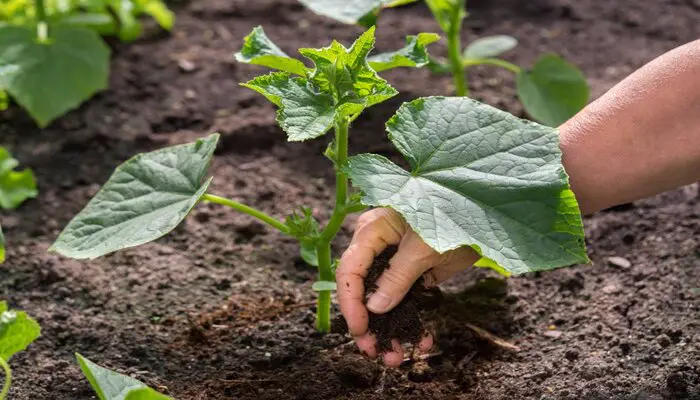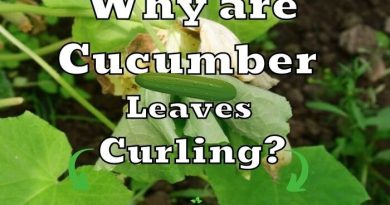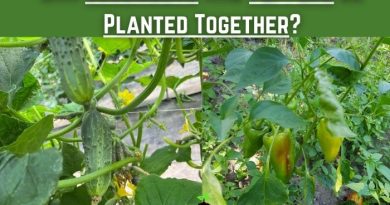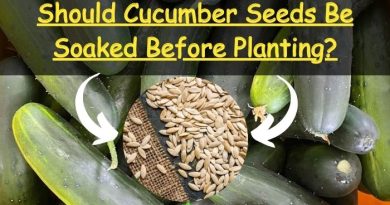Cucumber Plant Not Growing? How To Encourage Growth!
When cucumbers stop growing, that’s a nightmare for many gardeners, including myself. If you find yourself wondering, “Why is my cucumber plant not growing?” you’re in the right place.
If your cucumber plant is not growing, it may be due to a variety of factors, such as low temperatures, a lack of sunlight, poor soil quality, a lack of water, or transplant shock. To encourage growth, ensure your cucumbers receives a minimum of 6–8 hours of direct sunlight per day, use well-draining soil, water consistently, and take steps to minimize the stress of transplanting. By addressing these issues, you can help your cucumber plant grow and thrive.
Today I will give you a complete overview of all possible causes why cucumber plants are not growing and provide you with practical tips to help you get your cucumber growing again.
So, grab your gardening gloves and let’s embark on this journey together. Get ready to unlock the secrets to cultivating robust, vibrant cucumber plants that will yield bountiful harvests.
Reasons Why Cucumber Plants May Not Be Growing
1. Low temperatures
Cold weather is one of the most common reasons for the growth inhibition of cucumbers. Cucumber is a heat-loving crop and the optimum temperature required for normal development is 73-77°F (23-25°C) during the day and 59-64°F (15-18°C) at night.
While mature plants are usually unaffected by their resilience and the now warmer night temperatures, seedlings grown in the unheated greenhouse in particular suffer from the high temperature fluctuations between sunny days and nights that are still close to the frost line.
It is known that the growth of the cucumber plants takes place at night. For this reason, a decrease in night temperature to below 57°F (14°C)(and this phenomenon is not uncommon in the middle lane in June) leads to the fact that the bushes stop growing.
You take them outside during the day and gradually acclimate them to the climate. Naturally, they are put back in a warm location at night. However, excessive temperature changes should be avoided.
Treatment
If your cucumbers grow in open ground, then during the cooling period, install arcs over them and cover them with a film or any non-woven material. This technique will protect the cucumbers from low night temperatures.
With a strong decrease in temperature at night, you can put bottles of hot water on the beds. This method is also suitable for greenhouses.
In this case, ventilation of greenhouses, regular straits of row-spacings with cool water will help because the nights in our area are cold and the days are warm. In this case, I put basins of water in the aisles.
During the day, the water heats up, and at night it gives off its heat. I tested this method on my site more than once.
2. Nutrients Deficiency

Another reason why your cucumber plants are not growing is a lack of nutrients, most often nitrogen. It is this element that is “responsible” for the growth of green mass. Its deficiency will also be indicated by pale, sometimes yellowish, leaf blades and thin, stiff lashes.
Cucumber plants require appropriate nutrients, particularly phosphorus and potassium, for healthy fruit growth. Cucumbers that are deformed might result from a lack of certain nutrients.
| Nutrient Deficiency | Effects on Cucumber Growth |
|---|---|
| Nitrogen | Stunted growth, yellowing of lower leaves, reduced fruit size and yield. |
| Phosphorus | Slow growth, purplish leaves, reduced fruit size and yield. |
| Potassium | Weak stems, yellowing and curling of leaves, reduced fruit size and yield |
| Magnesium | Yellowing between leaf veins, stunted growth, reduced fruit size and yield |
| Calcium | Stunted growth, blossom end rot, reduced fruit size and yield |
| Iron | Yellowing of leaves with green veins, stunted growth, reduced fruit size and yield |
| Manganese | Yellowing between leaf veins, stunted growth, reduced fruit size and yield |
| Zinc | Stunted growth, yellowing of leaves, reduced fruit size and yield |
University of Florida IFAS Extension. https://edis.ifas.ufl.edu/mv123.
West Virginia University Extension Service. https://extension.wvu.edu/lawn-gardening-pests/plant-disease/nutrient-deficiencies-in-plants.
It’s important to note that nutrient deficiencies can have overlapping symptoms, so it’s important to properly diagnose the issue before attempting to correct it.
Soil testing can help determine which nutrients are lacking in the soil and guide fertilizer application. Proper fertilization and soil management can help prevent nutrient deficiencies in the future.
Treatment
The growth of flowers, fruits, and seeds depends on phosphorus, while the “jack of all trades” quality of potassium is crucial for the health of the entire plant.
Use fertilizers with higher P and K values in the NPK value, generally. For cucumbers, an NPK with calcium and other micronutrients in the range of 2-5-3 or 5-10-10 would be optimal.
If the reason for stopping the growth of cucumbers was a lack of nitrogen, then the plantings should be fed with mineral or organic fertilizers with a high content of this element.
Urea will perfectly cope with this role : 1 tbsp. dissolve fertilizers in 10 liters of water and process the plants by leaf.
Adherents of organic farming can use chicken manure. To prepare its infusion, fill any container with 1/10 of chicken manure and top up with water.
Stir the contents regularly for 2-4 days, and then dilute the finished dressing with water at a rate of 1:10 and water the plantings. The norm is 0.5–1 liter per bush.
3. Lack of Water

Because cucumbers are a moisture-loving plant, a lack of water can also prevent them from growing. This is especially true for sandy soils, from which moisture evaporates very quickly.
Without enough water, the plant cannot absorb the nutrients from the substrate. You can usually recognize this by withered leaves and hanging parts of plants.
Under severe water shortages, cucumbers react with withered leaves, drooping twigs, and finally shoots, with the whole plant dying off.
If, on the other hand, the lack of water is not permanent but only moderate, the highly water-containing plant will initially stop growing.
Treatment
| Stage of Growth | Water Needs |
|---|---|
| Seedling | Keep soil moist, but not waterlogged. Water daily or as needed to maintain moisture. |
| Vegetative growth | Water deeply once or twice a week, depending on weather conditions. Allow soil to dry out slightly between waterings. |
| Flowering and fruiting | Water deeply once or twice a week, depending on weather conditions. Ensure soil remains consistently moist, but not waterlogged. |
| Hot, dry weather | Water deeply and more frequently, as needed to maintain moisture. Consider providing shade or mulching to retain moisture. |
https://careofgarden.com/cucumber-growth-stages/
Cucumbers growing in open ground are watered every 1-2 days during the drought period. The amount of water should be enough to wet the soil to a depth of at least 10 cm; this is where most of the plant’s root system is located.
For greenhouse cucumbers, watering should be even more frequent. Usually in a greenhouse, plants are watered every day, and on the hottest days, twice a day, early in the morning and late in the evening.
4. Poor Planting Technique

Poor planting techniques put a cucumber plant at a disadvantage from the beginning and may result in growth issues. For healthy development, the veggies require nutrient-rich soil that has been modified with compost or manure.
Trying to use every meter of a small area to good use, summer residents often plant cucumbers too close to each other, causing cucumber plant to not grow.
The fact is that if planted too densely, the bushes receive an insufficient amount of light and air, which slows down their development.
In addition, due to poor ventilation, plants are more likely to be attacked by diseases and pests.
According to Harvest to Table, plants that are too closely packed together produce crowded, stunted plants while those that are too far apart suffer from inadequate pollination. Leave 8 to 12 inches between plants.
Additionally, planting timing matters. Cucumbers might have reduced development due to cold conditions if they are planted too early. Although cucumber vines do develop quickly, we occasionally encounter typical cucumber plant issues.
Treatment
For different varieties of cucumbers, the optimal distance between plants will differ. On average, cucumbers are planted at a distance of 30–35 cm in a row and about 70–80 cm between rows.
There are two possible solutions to the problem:
- Thin out seedlings by removing excess cucumber plants. You can try to transplant extra seedlings to another place, but cucumbers do not tolerate transplanting very well, so there is little chance that the transplanted plant will be accepted and give a good harvest.
- In order not to pull out the seedlings, but at the same time provide them with enough light and air, try growing cucumbers in a vertical way—on a trellis.
Transplant Shock
Transplant shock can have a significant impact on the growth of cucumber plants. Cucumber plants are particularly sensitive to transplant shock, and if not properly cared for, they may not grow properly or may even die.
One of the main impacts of transplant shock on cucumber growth is stunted growth.
When cucumber plants experience transplant shock, their root systems may become damaged, which can make it difficult for them to absorb nutrients and water from the soil. This can lead to slower growth and smaller fruits.
Treatment
To minimize the impact of transplant shock on cucumber growth, gardeners can take several steps.
These include hardening off seedlings before transplanting, watering plants thoroughly before and after transplanting, and providing shade or protection from wind and extreme temperatures in the days following transplanting.
5. Insufficient Sunlight
Insufficient sunlight can indeed hinder the growth of cucumber plants as cucumbers require a lot of sunlight to grow and produce healthy fruit.
Cucumbers are sun-loving plants and require a minimum of 6–8 hours of direct sunlight each day to thrive. Sunlight is essential for photosynthesis, the process by which plants convert light energy into food.
Without enough sunlight, cucumber plants may not be able to produce enough food to support healthy growth and fruit production.
The reason for the slow growth of seedlings may also be an incorrectly chosen place for a cucumber bed.
The optimal development of this culture is possible only in a sunny area, protected from strong and cold northern winds.
A cucumber can also grow and bear fruit in partial shade, but the yield will be lower than in sunlit beds.
Table summarizing how insufficient sunlight affects cucumber plant growth:
| Effect of Insufficient Sunlight | Explanation |
|---|---|
| Stunted growth | Cucumber plants require sunlight to produce energy through photosynthesis. Without enough sunlight, they may not be able to produce enough energy to support healthy growth. |
| Reduced fruit production | Cucumber plants need sunlight to produce flowers and fruit. Without enough sunlight, they may produce fewer fruits or smaller fruits that are not marketable. |
| Weak plants | Low light levels can weaken cucumber plants and make them more susceptible to pests and diseases. Weak plants may have reduced resistance to pests and diseases, making them more vulnerable to damage. |
| Delayed maturity | Insufficient sunlight can slow down the growth and development of cucumber plants, which may delay the maturity of the fruit. This can be problematic for growers who need to harvest their crops at a specific time. |
https://plantvillage.psu.edu/topics/cucumber/infos.
Treatment
Do not plant cucumbers in the shade of trees, shrubs, or near tall plants. If, nevertheless, it turned out that neighboring tall plants create a shadow for the cucumber bed for the whole day, try to get rid of them.
A dense wall of tall or climbing crops will help protect plantings from strong winds: sunflower, corn, or beans planted on the north side of the cucumber bed.
6. Poor Soil Conditions
Nutrient-rich soil with a pH of about 7 is necessary for cucumber growth. The plants won’t be able to absorb the required nutrients for proper development if the soil is excessively acidic or alkaline.
As a result, you must assess the soil’s pH and modify it as appropriate. You’ll need a soil testing kit for this, which you can get at your neighborhood garden center.
One technique to make sure the soil is suitable for healthy development is to add a lot of mature organic compost before planting your cucumbers.
7. Weather Conditions
Planting the cucumber too early is one of the most frequent errors that people have a tendency to make. You should be aware that the cucumber plant thrives in the warm months in general. Additionally, it requires a lot of sunlight to flourish effectively.
The ideal time to plant cucumber seeds is two weeks following the date of the last frost. The temperature of the soil must be at least 70 degrees F for germination to occur.
Additionally, as was already said, these plants require a lot of sunshine, therefore it’s crucial that you put the cucumber in a location where it will have all day long exposure to the sun.
Frequently Asked Questions
You can feed cucumbers for growth and development with potassium chelating yeast : For cooking, you need to defend the water in a warm place so that its temperature becomes at least 34 ° C.
Pour 500 ml of warm water into the container, add 5 g of dry yeast and half a teaspoon of sugar.
Cucumber plants typically start growing within 7-14 days after sowing the seeds. However, the growth rate may vary depending on various factors, including temperature, sunlight, soil conditions, and cucumber variety. Providing optimal growing conditions and maintaining proper care can help expedite the growth process and ensure healthy plant development.




